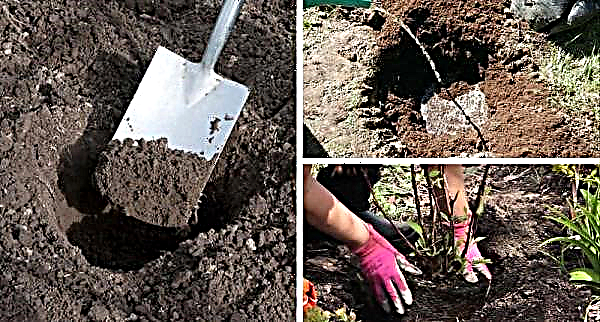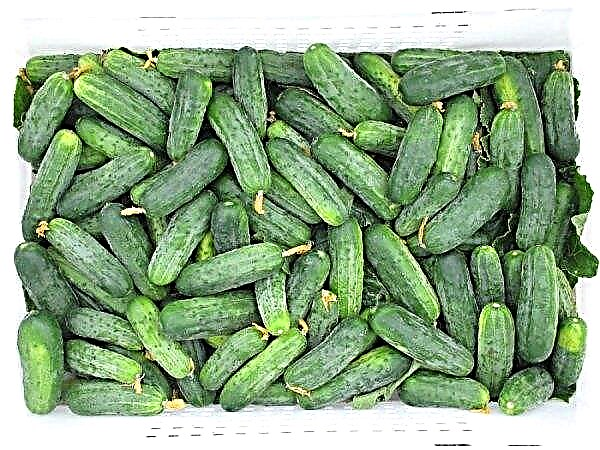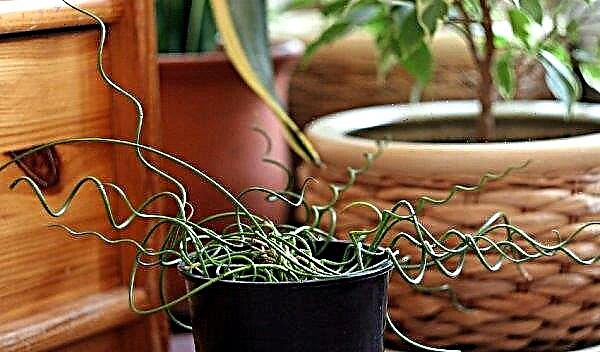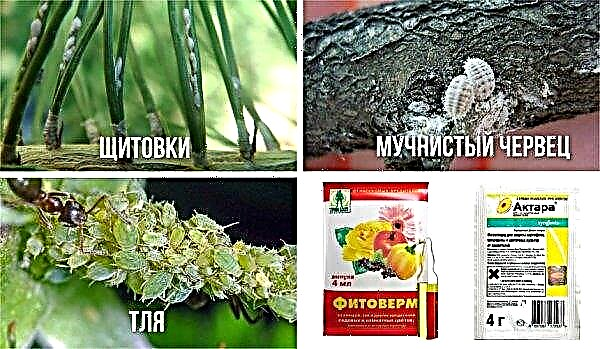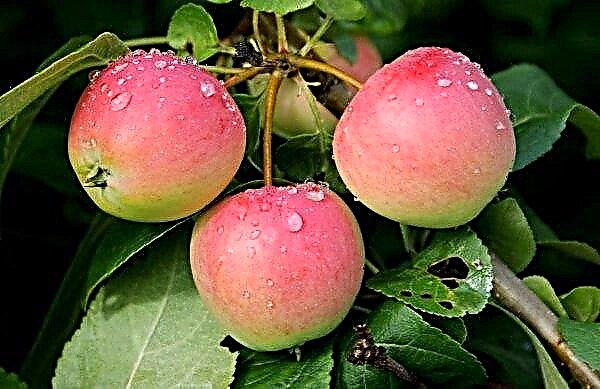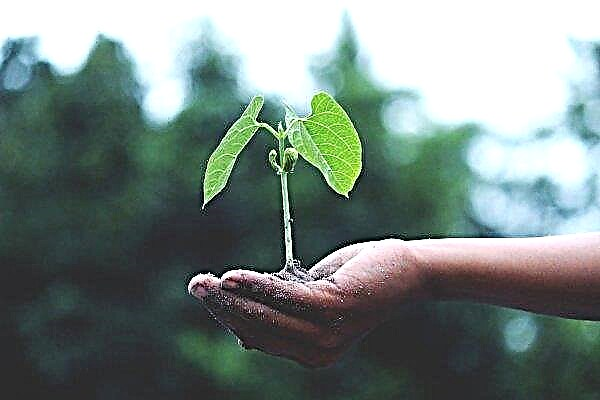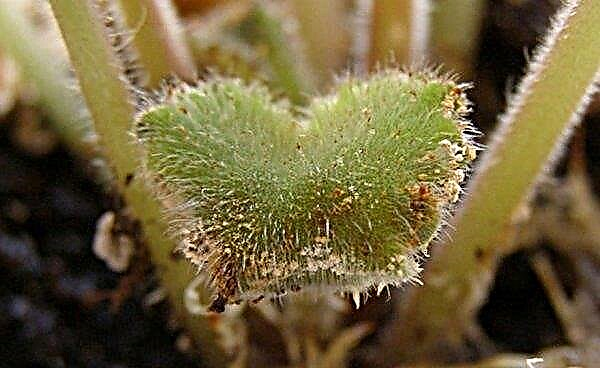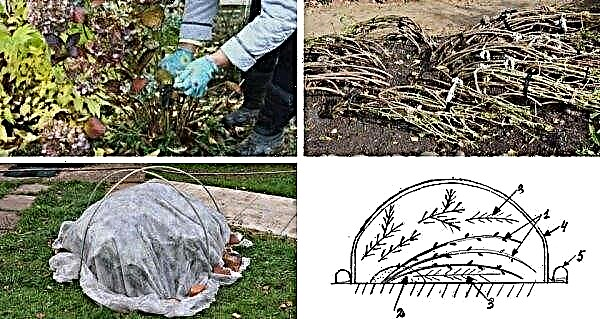In a healthy cucumber bush, the leaf plates have a bright green color, and it should be completely plain. If bright spots, white dots and other discolourations suddenly appear on the leaves, this is definitely a bad sign and requires certain measures. How to determine the cause of such a phenomenon and save the culture from illness and death will be described below.
Why white spots appear on the leaves of cucumbers and what to do
The main problem is that the appearance of spots on the leaves of a cucumber can respond to various problems. This can be a momentary reaction to adverse climatic conditions or gardener's mistakes, a symptom of a dangerous disease or the consequences of an attack by pests.
Since the answer to the question of how to treat the plant directly depends on what exactly caused the discoloration of the leaves, the correct diagnosis in this situation is extremely important. For this, the agrarian needs to focus on additional symptoms and signs.
Sunburn leaf
Despite the fact that cucumber is a light-loving crop, it does not tolerate direct sunlight. However, most often, sunburns on the leaves of the plant appear if, under bright lighting, water gets on them.
Cucumber seedlings especially often suffer from sunburn in the first days after planting it in open ground. It is very easy to distinguish leaf burns from diseases and pests.Important! You can water cucumbers on leaves only in the early morning or evening, so that by the time the bright sun appears, the leaf plates are completely dry. Otherwise, the light reflected in droplets of water on the foliage turns it into a kind of lens, which, in fact, causes severe burns.
It is only necessary:
- analyze how the watering of the beds was carried out, and compare it with the intensity of lighting;
- make sure that, except for bright spots, there are no other signs of damage to the culture.

The combination of light spots and wilting leaves testifies to the negative effects of the sun. Burns on the leaves are not a disease, and therefore do not need special treatment. After making sure that this is the problem, you only need to adjust the irrigation mode and protect the bed from the midday sun using a light-scattering shelter.
However, it is worth noting that spots on the leaves can also appear for other reasons associated with improper agricultural technology, for example, a sharp cooling, frequent but sparse watering, poor or waterlogged soil at the roots, etc.
All these factors should also be analyzed when the color of the cucumber leaves changes, before starting the preventive treatment of the culture with pesticides.Diseases and pests
A more serious intervention is necessary if the plant was attacked by pests or pathogenic fungi, traces of vital activity of which in cucumbers are also reflected in the condition of the leaf and its color.
Powdery mildew
Powdery mildew is one of the most common fungal diseases affecting pumpkin crops.
Several types of fungi can cause it, in particular, Oidium erysiphoides Fr. (Erysiphe cichoraccarum D.C.f. cucur-bitacearum Poteb.), Erysiphe communis (Wallr) Fr. (also known as Erysiphe polygoni D.C.), as well as Sphaerotheca fuliginea Poll f. cucurbitae Jacz, and it was noted that the first of these pathogens most often affects plants in colder regions, while the third is more characteristic of the southern regions. 1. Oidium erysiphoides Fr. 2. Erysiphe communis (Wallr) Fr. 3. Sphaerotheca fuliginea Poll f. cucurbitae Jacz
1. Oidium erysiphoides Fr. 2. Erysiphe communis (Wallr) Fr. 3. Sphaerotheca fuliginea Poll f. cucurbitae Jacz
Among the reasons that increase the likelihood of damage to cucumbers by powdery mildew are:
- violation of crop rotation rules (planting crops of the pumpkin family in the same place for several years in a row);
- sharp temperature changes;
- high humidity and moderately warm weather in the temperature range + 16 ... + 20 ° С (favorable conditions for the development of the pathogen);
- a combination of low humidity with bright lighting (the plant itself is weakened).
Powdery mildew much more often affects plants planted in open beds, where the disease can destroy up to half the crop. However, cucumbers growing in a greenhouse, where the pathogen can be carried by the wind through doors or windows, are also not immune from the disease (it is the bushes located near such "gates" that usually get sick first).Important! The spread of powdery mildew is also promoted by some weeds, in particular, thistle and plantain, on which the pathogen can persist for a very long time.
The maximum activity of the causative agent of powdery mildew occurs in mid-summer, so cucumber seedlings rarely suffer from this disease. Nevertheless, it is necessary to know that due to a very short (sometimes only 3 days) incubation period per season, the fungus can form up to a dozen generations.
Typical symptoms of powdery mildew on cucumbers are:
- white coating on the back of the sheet plate;
- spots on the front side of the leaf - at first light, darkening and merging with each other as the disease develops;
- acquisition by a leaf of a characteristic wavy shape;
- arching and drying of leaves along the edges;
- over time, the appearance of light plaque on the stem;
- very small fruits with bitter taste;
- drying and necrosis of individual lashes or the entire bush (final stage).

If the first signs of infection are found, it is necessary to immediately treat all the plants in the garden with a suitable fungicidal preparation.
The most effective remedies for powdery mildew are:
Find out also

- "Topaz";
- "Saprol";
- "Topsin";
- Bayleton;
- "Azocene";
- "Quadrice";
- "Privent";
- Tiovit Jet;
- "Kuproksat";
- "Gates";
- Cumulus.
White mosaic
If powdery mildew is caused by pathogenic fungi, against which there are many very effective drugs, then the white mosaic is a disease of a viral nature. Its causative agent is Cucumis mosaic cucumovirus (CMV) 2A. 1. Cucumis mosaic cucumovirus virus
1. Cucumis mosaic cucumovirus virus
From the other two types of cucumber mosaic (green speckled and ordinary), this disease is distinguished by the appearance of white-yellow small spots on the leaves, concentrating mainly along the veins. A characteristic feature of the mosaic is laid down in the name of the disease: at the initial stage, the spots are small and openwork in shape - rings or asterisks.
As the disease spreads, they blur, merge with each other, sometimes darken and capture the entire leaf plate, which becomes a plain yellow or white. The bush slows down development and poorly bears fruit.
Mosaic virus can persist in fruits, seeds, fragments of affected plants, as well as in garden tools. The disease most quickly captures thickened greenhouse beds, although it is still wrong to say that non-observance of the optimal distance between plants is a direct cause of infection.
Important! The maximum germination of cucumber seeds is shown in the second–third year after collection. An additional bonus was the fact that by this time the viability of the white mosaic virus located in the seeds has time to significantly decrease.
The incubation period for the development of a viral infection is quite large, so the disease rarely manifests itself in seedlings. Even if the causative agent of the white mosaic was in the seeds, distinct symptoms of the lesion are observed approximately 40 days after planting, by which time the seedlings are usually already planted in open ground.
Cucumber mosaic, like most other plant viral infections, is not treated with pesticides. At the first signs of the disease, the affected plant must be removed from the garden. Moreover, in order to prevent a threat in this case, experts recommend removing the topsoil in the greenhouse to a depth of at least 10 cm and filling in with fresh soil instead.
Today, the only method of protection against white mosaic is pre-sowing seed disinfection. In this case, the heating method is useless, since Cucumis mosaic cucumovirus dies at higher temperatures than the embryo itself.
High efficiency is shown by soaking the seeds for 60 minutes in a solution of trisodium phosphate (concentration of 15%) and subsequent washing under running water for the same amount of time.
Did you know? Specialists in the field of molecular genetics and biotechnology have relatively recently developed a method of vaccinating plants against viral infections. In particular, seedlings of cucumbers can be inoculated with a strain of the green mottled mosaic virus. Since the white mosaic is a special kind of green, it is likely that such a vaccine will protect the plant from both diseases, however, it is apparently still a long way to the widespread introduction of the discovery.
Spider mite
The spider mite is the worst enemy of many garden, horticultural and ornamental crops, but cucumbers are a favorite treat of this pest. The main reason here is that the tick feels best in conditions of limited ventilation, constantly warm temperature and dry air. Usually this is exactly the microclimate in cucumber greenhouses.
Unlike most fungal infections, a spider mite with the same probability can be found both on an adult plant and on a recently sprouted seedling, however, the faster it is neutralized, the higher the probability of preserving the crop.
Typical symptoms of spider mite life are:
- the appearance on the cucumber leaves of small dots of white color - traces of injections through which the pest sucks the juice from the plant;
- the concentration of these points is primarily at the base of the leaf, and not over its entire surface (the pest moves along the stem of the plant and, reaching the leaf plate, immediately begins to satisfy its hunger);
- the appearance on the bush of threads, similar to cobwebs, which eventually tighten with a continuous grid both leaves and stems.

If you look closely, you can see on the infected plant the pest itself: the spider mite is a small arachnid, but still noticeable to the naked eye (its length is several millimeters).
Since ticks are not insects, to combat them, not insecticides should be used, but special preparations - acaricides (from the ancient Greek "ἄκαρι" - "tick"). Many popular antiparasitic drugs, however, have a systemic insecticidal and acaricidal effect.
Among the most effective drugs for combating spider mites are usually called:
- "Actellicus";
- "Kartofobs";
- Neoron
- "Karbofos";
- "Dacofol";
- Plant Pin;
- "Etisso."
Did you know? An effective, safe and witty way to combat the spider mite is to use its natural enemy against the pest. Such, in particular, is a predatory and very gluttonous tick called phytoseyulyus. It can be purchased in specialized stores and simply run into a greenhouse or in a garden, the only problem is that such a “live product” is very expensive - about $ 20 per jar.
Ascochitosis
Ascochitosis (also known as stem cancer or black mycospheresis stem rot of a cucumber) is another disease of a fungal nature that is common in cucumbers. Its pathogen is the phytopathogenic fungus Ascochyta cucumeris from the genus Ascochyta lycopersici.
 Ascochyta cucumeris virus
Ascochyta cucumeris virus
This infection usually affects adult plants that have entered the fruiting phase. In seedlings, it can be met rarely. First of all, cucumbers grown in greenhouses are at risk. If adequate measures are not taken, the fungus spreads very quickly to the entire bush and causes its death, as a result of which the farmer can lose from a third to half of the crop.
Most often, mycelium of the fungus is found in cucumber seeds; in most cases, the disease is not transmitted through the soil. The viability of Ascochyta cucumeris is very high, the fungus feels good in different ranges of temperature (+ 10 ... + 32 ° C) and humidity (20 ... 100%).
However, with the combination of warm and humid air, the development of the pathogen is significantly accelerated. For this reason, hothouse cucumbers suffer most from ascochitosis in mid-spring, when the bright sun already warms up the greenhouse well, but the cool air outside the windows does not allow direct and constant ventilation.
For ascochitosis, the following symptoms are characteristic:
- infection begins with stems on which oval or rounded areas of a grayish tint and watery texture appear; with time they darken, and later dry out and become almost white;
- the stem cracks and begins to ooze with brown or white liquid;
- at first, the defeat does not externally affect the bearing;
- as a lesion, all aboveground organs are covered with a large number of black dots;
- the leaf plate is affected starting from the edge where round large (4–5 cm in diameter) spots of irregular shape appear, are lighter on the periphery;
- the spots on the leaves are first brown, then whitish-yellow in color, with well-visible fruiting bodies of the fungus, sometimes arranged in rows, in other cases - randomly;
- over time, the leaf completely turns light yellow (chlorotic) and fades;
- fruits in the later stages of the disease, depending on the nature of its course, may look different: dry out, staying solid, then blacken and mummify, crack or “rust” - become soft and mucous.

It is very difficult to fight with ascochitosis, therefore, fungicidal preparations are recommended to be used for preventive purposes, at the stage of pre-sowing seed treatment.
In this case, maximum efficiency is shown by such means as:
- "Saprol";
- "Vincite";
- "Tiram" (the effectiveness of this tool, some experts, however, dispute).
If the first signs of ascochitosis are still found on the cucumber, it is first necessary to remove all the fragments affected by the fungus.Did you know? The mushroom kingdom is considered the most numerous and, at the same time, the least studied in biological science. According to various sources, there are from 100 thousand to 3.8 million different mushrooms on Earth, and some scientists say that at least 90% of these organisms are still unknown to humans.
Then the plant can be processed:
- leaves - Bordeaux liquid or a mixture of urea and copper sulfate (spraying);
- stalks - a mixture of copper and chalk (dusting).
Anthracnose
An equally dangerous fungal infection that affects cucumbers and other cultures of the pumpkin family is anthracnose, popularly known as the "copperfish".The causative agent of this disease is the ascomycete colletotrichum (Colletotrichum). Fungus Colletotrichum
Fungus Colletotrichum
Greenhouse cucumbers suffer from anthracnose more often, but defeat is also possible on open beds.
Sources of infection can be:
- plant residues;
- pests;
- seeds;
- wind;
- rain or irrigation water;
- city trash.
Infection can begin at any stage of the development of the bush, so experts recommend that you carefully examine both seedlings of cucumbers and adult plants for the first signs of the disease.Important! Symptoms of anthracnose largely depend on the weather: at high humidity, the stems decay and break off more often, in the dry period they dry and crack.
These include:
- small brown hollows on the root neck and seedling stem (sometimes the lesion site is so large that the stem simply breaks off);
- yellow or brown spots of different sizes (from 3 to 40 mm in diameter) on the leaves, usually along the edges and along the veins;
- similar spots on the stems;
- the beginning of the development of the disease - from the bottom of the bush;
- as the infection spreads, the spots increase in size, merge with each other, dry and fall out, forming characteristic holes or cracks;
- brittle stems in the affected areas;
- light or pink oblong spots on the fruit, penetrating into the cucumber tissue 3-4 mm;
- drying of the bush (last stage).

To combat copperfish, fungicidal preparations of systemic or contact action are used.
A good effect is shown by processing cucumbers by such means as:
- "Poliram";
- Cumulus
- "Topaz";
- "Quadrice";
- "Previkur Energy" (not suitable for open ground);
- Abiga Peak;
- Tiovit Jet;
- "Zircon".
Did you know? It has been observed that cucumber varieties with a darker leaf color are less susceptible to powdery mildew.
Preventative measures
To strengthen the immunity of cucumbers, prevent damage to plants by pests and diseases, as well as protect against other adverse environmental factors you must adhere to the following preventive measures:
- after collecting the last crop, thoroughly clean the bed from all plant residues;
- regularly weed during the season to remove weeds not only from the bed itself, but also from adjacent areas;
- Do not plant the same or kindred crops on the garden for several years in a row, correctly select predecessors and followers, observing crop rotation rules;
- if possible, choose varieties of cucumbers that are most resistant to adverse conditions, diseases and pests;
- disinfect them before planting seeds (an exception to this rule is seed material of European production that underwent complete preplant preparation before packaging);
- to plant bushes at a sufficient distance from each other, to prevent excessive thickening of the beds;
- immediately remove from the garden plants affected by an incurable infection of a viral nature;
- regularly carry out pest control, which are the main carriers of many pathogenic organisms - bacteria, viruses and fungi;
- when processing the garden or greenhouse, use only clean, preferably disinfected, equipment;
- prevent sudden changes in night and day temperatures in greenhouses;
- protect plants from the scorching rays of the midday sun;
- water the plants with warm water, preventing it from falling on the leaves in the daytime;
- comply with the fertilizer application regimen - both organic and mineral;
- for the winter, apply antifungal and insecticidal preparations to the soil, giving preference to biological agents.

White spots on cucumber leaves should not appear. If this happened, it is necessary first of all to analyze what events preceded this and whether this is due to improper care - a sunburn, improper watering, hypothermia. Subsequently, depending on the concomitant symptoms, specific treatment measures are taken, however, you should try to take care of the garden in such a way that you do not have to contact potent and highly toxic pesticides.

